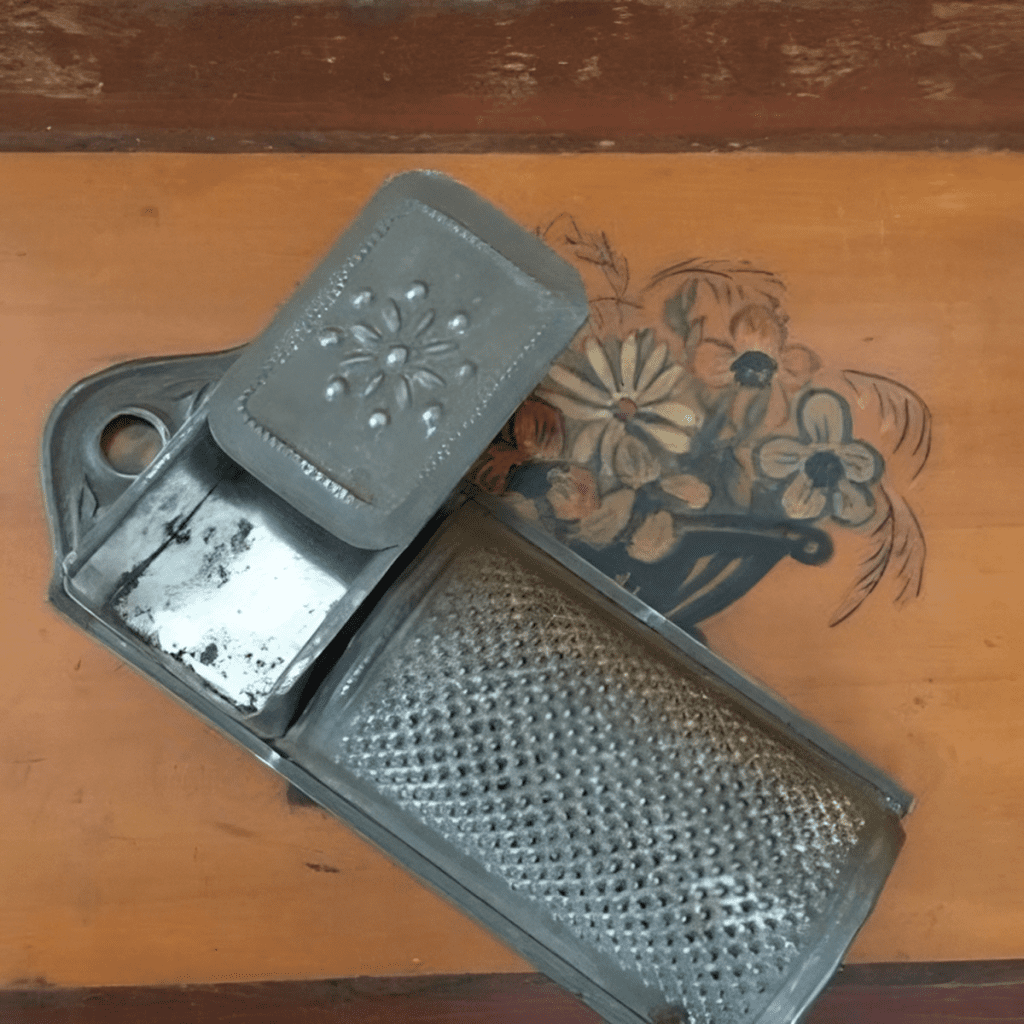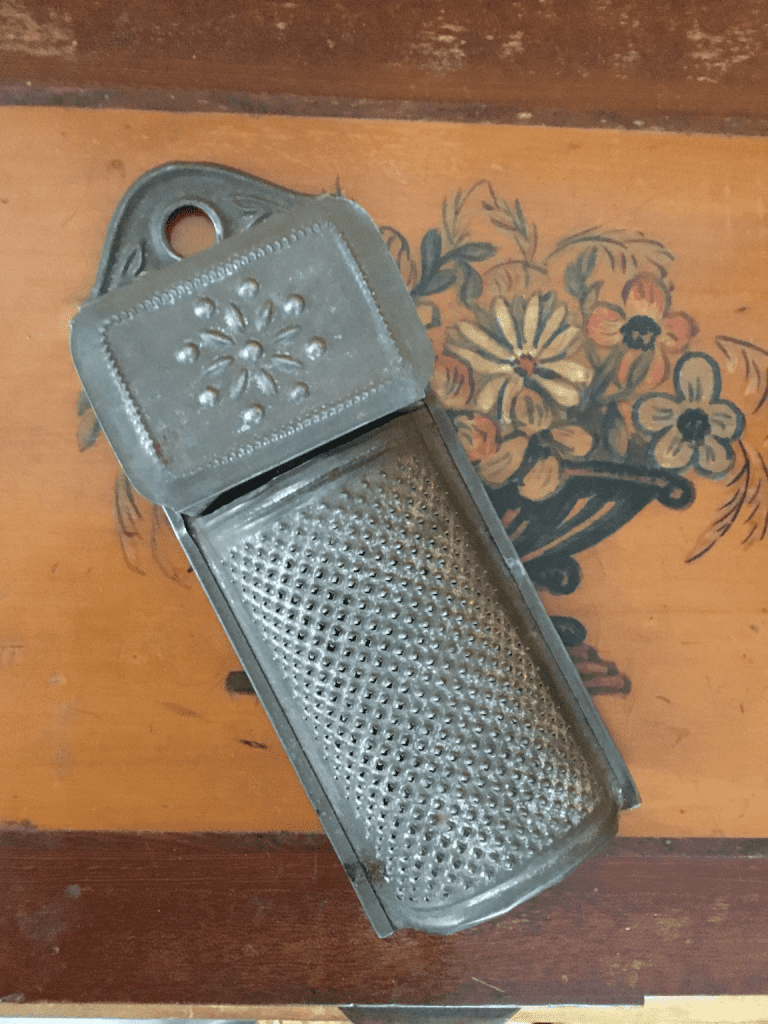The antique nutmeg grater, a seemingly simple yet captivating kitchen tool, holds a profound place in culinary history. More than just a functional object, it represents an era of spice trade, cultural exchange, and the evolution of kitchenware. Nutmeg, the spice it serves, was once more valuable than gold, and the grater designed to prepare it was an essential piece in many households.
In this article, we’ll explore the fascinating journey of the antique nutmeg grater, its historical background, and its enduring legacy in both cooking and culture.

Historical Background: The Origin of Nutmeg and Its Value
Nutmeg, a spice known for its warm, sweet aroma, has its roots in the Banda Islands of Indonesia. For centuries, this remote cluster of islands was the only place in the world where nutmeg trees grew. By the 15th century, nutmeg became one of the most coveted spices in the global spice trade. Its rarity and unique flavor profile made it a luxury item, symbolizing wealth and status across Europe.
During this time, European traders and explorers risked their lives to secure access to nutmeg. The spice was believed to possess not only exceptional flavoring abilities but also medicinal properties, such as aiding digestion and relieving pain. Nutmeg’s significance in trade and medicine led to the creation of specialized tools to harness its full potential, and thus, the antique nutmeg grater was born.
The Rise of Nutmeg Graters: From Luxury to Kitchen Staple
As the demand for nutmeg surged in the 16th and 17th centuries, the need for a practical tool to prepare the spice grew. Early nutmeg graters were often made from high-end materials like ivory, silver, and wood. These elaborate designs reflected the status of the user and the importance of the spice. Some of these graters were small enough to be carried in one’s pocket or incorporated into lavish dinnerware sets, further emphasizing nutmeg’s association with wealth.
By the 18th and 19th centuries, nutmeg became more accessible to the general public, and with that shift, nutmeg graters also transitioned from rare luxury items to household essentials. As the spice became a staple in European and American kitchens, so did the grater. They were now made from more affordable materials, including tin and pewter, allowing more people to incorporate freshly grated nutmeg into their cooking.
Craftsmanship: Intricate and Functional Design
Antique nutmeg graters are renowned for their intricate craftsmanship, blending both form and function. The graters typically featured a cylindrical or flat design with a textured surface designed to finely shave the nutmeg seed. Some included small compartments to store whole nutmeg seeds, while others were compact enough to fit neatly into spice cabinets or even be carried as personal accessories.
The grater’s surface, often made from metal, was perforated with small, sharp holes, allowing users to scrape the hard seed against it to produce fine, fragrant shavings. This design was incredibly efficient, extracting the rich flavors and oils from the nutmeg, making it an indispensable tool in both professional and home kitchens.
The Culinary Uses of Nutmeg: Enhancing Flavor in Timeless Dishes
Nutmeg’s versatility in cooking is what made the nutmeg grater a crucial tool in the kitchen. From sweet to savory dishes, freshly grated nutmeg adds depth and warmth to a variety of recipes. In European households, nutmeg became an essential ingredient in baked goods such as cakes, pies, and cookies. It was also used in creamy sauces, soups, and mashed potatoes to add a subtle spice that elevated the dish’s complexity.

One of the most famous uses of nutmeg is in beverages. Warm drinks like eggnog, mulled wine, and hot chocolate are enhanced by a dash of freshly grated nutmeg. The spice’s aromatic quality and ability to blend seamlessly with other flavors make it a favorite in both holiday drinks and comforting winter recipes.
Beyond the kitchen, nutmeg was also believed to possess medicinal properties. Many households used nutmeg as a natural remedy for digestion issues, insomnia, and inflammation, making the grater not just a kitchen tool but a part of a home’s wellness routine.
The Legacy of Antique Nutmeg Graters
Today, antique nutmeg graters hold a special place in both the culinary and antique worlds. These charming artifacts are treasured by collectors for their unique designs, historical value, and craftsmanship. Some even consider them works of art, with intricate engravings and designs that reflect the time in which they were made.
For many, these graters serve as decorative items, adding a vintage charm to kitchens and dining spaces. But their legacy goes beyond aesthetics. They represent an era when spices like nutmeg were prized and the tools to prepare them were crafted with care and precision.
The global spice trade, which brought nutmeg from the far reaches of Indonesia to the tables of Europe and America, is symbolized by these graters. Their existence reminds us of the cultural exchanges and culinary evolutions that shaped how we cook and enjoy food today.

Why Antique Nutmeg Graters Are Still Relevant Today
While modern kitchens are equipped with a variety of tools and gadgets, the antique nutmeg grater remains relevant, not just as a collector’s item but as a functional tool. Many culinary enthusiasts still prefer using traditional graters to freshly grind nutmeg, believing that the manual process enhances the flavor compared to pre-ground spices.
Moreover, in an age where people are rediscovering the value of artisanal and handmade goods, antique nutmeg graters stand out as a symbol of quality craftsmanship. They connect us to a time when kitchen tools were not mass-produced but carefully designed to serve a purpose while also being pleasing to the eye.
Conclusion: A Timeless Tool with a Rich Heritage
The antique nutmeg grater is more than just a kitchen tool; it’s a piece of history that tells the story of global trade, culinary traditions, and craftsmanship. From its origins in the spice trade of the 16th century to its place in the kitchens of today, the nutmeg grater has endured as a symbol of the spice’s enduring appeal.
Whether admired for its design or used for its intended purpose, the antique nutmeg grater continues to captivate those who appreciate the intersection of history, culture, and cuisine. It remains a delightful reminder of the role that spices and the tools to prepare them have played in shaping our culinary heritage.


